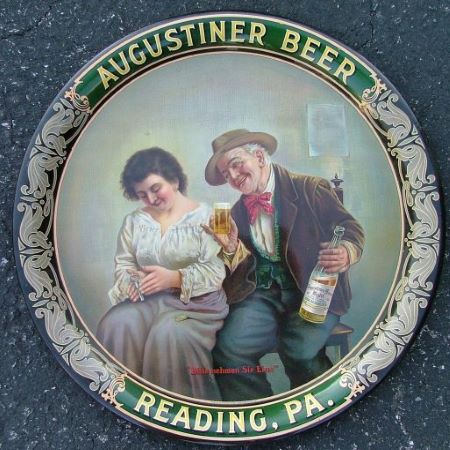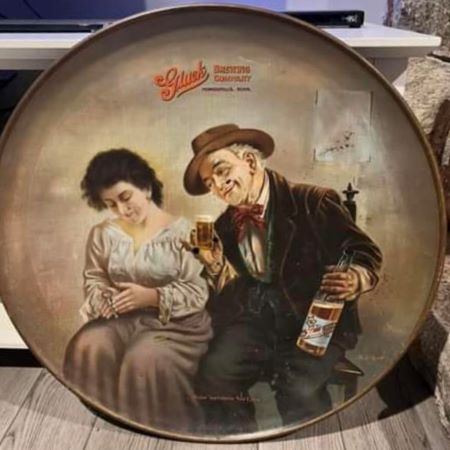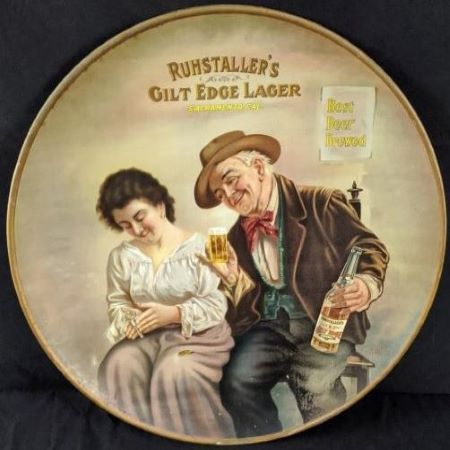Date: 1907 - 1915
Size: 13.5" x 16.5"
Type: Inverted Pie
Scarcity: Rare as a Tray
Value: $$$ to $$$$
Condition & Brewer Dependent
Size: 13.5" x 16.5"
Type: Inverted Pie
Scarcity: Rare as a Tray
Value: $$$ to $$$$
Condition & Brewer Dependent


Confirmed Brewer used Stock Trays
Non-Beer Related & Non-Tray Uses
General Comments
We believe this design dates to approximately the same time as “Here’s to You” based on the similarity of the rim design on the Buffalo Brewing example. While we’ve indicated a possible date range that’s quite wide for both of these designs that is a reflection of our uncertainty when it might have been issued, not that it was in the catalog for the whole time (which has been our tendency for other designs where we know or have a good guesstimate on when it was introduced). We do not believe this design was available in the Beach catalog nearly as long given that we don’t see the types of size and rim variations as we do with “Here’s to You”.
This design, featuring a somewhat flirtatious interaction between an older couple, is something of a stock trope of the era. Numerous similar examples can be found from a variety of the tray/sign manufacturers - we have captured many beer examples in the Couples Theme Page - as well as on other advertising media of the era. Oddly, to modern minds at least, there are far fewer examples featuring young couples unlike today where youth seems to be the focus. This might possibly be chalked up to the mores of the day governing proper socio-sexual behavior (anything but “proper” behavior was frowned up) or a pragmatic calculation of who typically held economic power to buy the advertised goods (usually older people).
We also believe this scene depicts a nostalgic representation of “the old ones left back in the old country” that was a not uncommon sentiment among immigrants of the time, which we believe to be within a few years of 1907, the peak year of European immigration to the United State. Immigrants from the era 1890-1920 represented a different demographic and profile than those who had come before. Earlier immigrants had come primarily from northern and western Europe (especially England and Germany) and frequently were of better means than later immigrants. Typically, entire families migrated to the United State with the full intention of permanently resettling in the US where class-based restrictions were far fewer, and they could pursue “the American Dream.” In the Civil War and following years the US Government actively encouraged such migration, most notably with the Homestead Act, which promised 160 acres of free land, most of it in America's expanding West, for anyone willing to work the land. As a result, many of these northern and western immigrants migrated to the rural and smaller town West and Midwest. Given the relatively high cost associated with migrating, these immigrants set down roots and established themselves for the long term.
By the late 1880s most of the land suitable for agriculture and economically productive uses had been claimed and the various programs and incentives were eliminated. As a result, immigration from northern and western Europe dropped considerably. However, with the advent of quick and relatively inexpensive steamship travel, the opportunity opened up to the economically lower class, many hailing from eastern and southern Europe. Coupled with the ceasation of “free land” in the West, more of these immigrants began to gravitate to urban centers and emerging modern industries that required a significant labor force. Now, instead of families migrating together, the profile of the immigrants shift to young, able-bodied men who could fill those labor needs. Many of these immigrants came with the intention of working seasonally in the US and returning home or staying for several years, amassing their savings and then returning “home”. This strategy was made possible to the rise of the immigrant shipping business which provided cheap passage, and the formation of inexpensive tenements in the cities that, while providing poor living conditions, had the virtue of being inexpensive. Given this growing immigrant population that retained strong ties to “the old country” with the full attention of returning, it’s understandable that some advertising, like this design, would seek to capitalize on that.
Size, Shape and Message Placement
We have only encountered a single tray-sized example of this design (all other examples where chargers), so we are uncertain whether it is representative or an exception. Like the Buffalo Brewing example of “Here’s to You”, the August Schneider brewery of Reading, PA example has a upscaled rim design with overlaid scrolling detail and advertising text windows with yellow text. The chargers have advertising text on the face, usually in black.
Hager & Price
This is another design that is neither discussed nor included in Hager’s catalog. As mentioned above this design appears most frequently as a large charger where average condition examples (all from breweries that we have seen) run in the low three figures; we’d anticipate that good to better examples would be in the mid-three figures. The lone tray-sized (a 13” convex pie) example we’ve seen, which was slightly below average condition, went for low four figures.
We believe this design dates to approximately the same time as “Here’s to You” based on the similarity of the rim design on the Buffalo Brewing example. While we’ve indicated a possible date range that’s quite wide for both of these designs that is a reflection of our uncertainty when it might have been issued, not that it was in the catalog for the whole time (which has been our tendency for other designs where we know or have a good guesstimate on when it was introduced). We do not believe this design was available in the Beach catalog nearly as long given that we don’t see the types of size and rim variations as we do with “Here’s to You”.
This design, featuring a somewhat flirtatious interaction between an older couple, is something of a stock trope of the era. Numerous similar examples can be found from a variety of the tray/sign manufacturers - we have captured many beer examples in the Couples Theme Page - as well as on other advertising media of the era. Oddly, to modern minds at least, there are far fewer examples featuring young couples unlike today where youth seems to be the focus. This might possibly be chalked up to the mores of the day governing proper socio-sexual behavior (anything but “proper” behavior was frowned up) or a pragmatic calculation of who typically held economic power to buy the advertised goods (usually older people).
We also believe this scene depicts a nostalgic representation of “the old ones left back in the old country” that was a not uncommon sentiment among immigrants of the time, which we believe to be within a few years of 1907, the peak year of European immigration to the United State. Immigrants from the era 1890-1920 represented a different demographic and profile than those who had come before. Earlier immigrants had come primarily from northern and western Europe (especially England and Germany) and frequently were of better means than later immigrants. Typically, entire families migrated to the United State with the full intention of permanently resettling in the US where class-based restrictions were far fewer, and they could pursue “the American Dream.” In the Civil War and following years the US Government actively encouraged such migration, most notably with the Homestead Act, which promised 160 acres of free land, most of it in America's expanding West, for anyone willing to work the land. As a result, many of these northern and western immigrants migrated to the rural and smaller town West and Midwest. Given the relatively high cost associated with migrating, these immigrants set down roots and established themselves for the long term.
By the late 1880s most of the land suitable for agriculture and economically productive uses had been claimed and the various programs and incentives were eliminated. As a result, immigration from northern and western Europe dropped considerably. However, with the advent of quick and relatively inexpensive steamship travel, the opportunity opened up to the economically lower class, many hailing from eastern and southern Europe. Coupled with the ceasation of “free land” in the West, more of these immigrants began to gravitate to urban centers and emerging modern industries that required a significant labor force. Now, instead of families migrating together, the profile of the immigrants shift to young, able-bodied men who could fill those labor needs. Many of these immigrants came with the intention of working seasonally in the US and returning home or staying for several years, amassing their savings and then returning “home”. This strategy was made possible to the rise of the immigrant shipping business which provided cheap passage, and the formation of inexpensive tenements in the cities that, while providing poor living conditions, had the virtue of being inexpensive. Given this growing immigrant population that retained strong ties to “the old country” with the full attention of returning, it’s understandable that some advertising, like this design, would seek to capitalize on that.
Size, Shape and Message Placement
We have only encountered a single tray-sized example of this design (all other examples where chargers), so we are uncertain whether it is representative or an exception. Like the Buffalo Brewing example of “Here’s to You”, the August Schneider brewery of Reading, PA example has a upscaled rim design with overlaid scrolling detail and advertising text windows with yellow text. The chargers have advertising text on the face, usually in black.
Hager & Price
This is another design that is neither discussed nor included in Hager’s catalog. As mentioned above this design appears most frequently as a large charger where average condition examples (all from breweries that we have seen) run in the low three figures; we’d anticipate that good to better examples would be in the mid-three figures. The lone tray-sized (a 13” convex pie) example we’ve seen, which was slightly below average condition, went for low four figures.

Click the Picture to Return to Meek & Beach Stock Catalog Page
The 'Stock' Exchange
The H.D. Beach Co. "Bitte Nehmen Sie Eins" (Please Take One)
The H.D. Beach Co. "Bitte Nehmen Sie Eins" (Please Take One)



